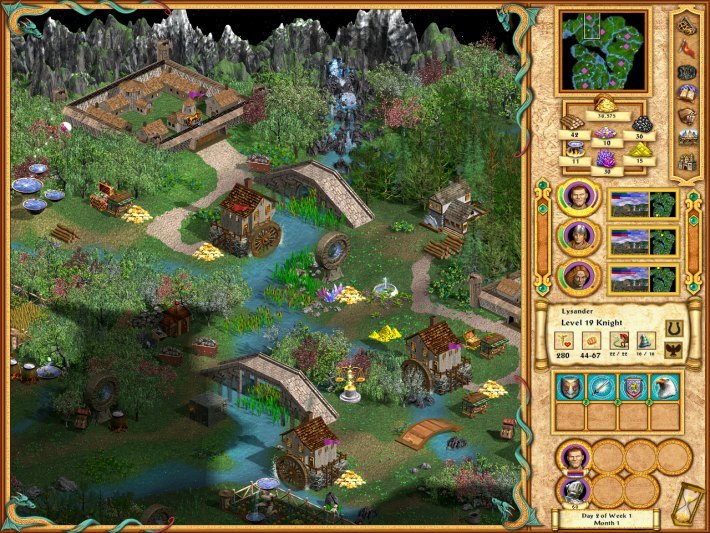Heroes of Might and Magic IV is a turn-based strategy game developed by New World Computing (bankrupt) and published by the 3DO Company (also bankrupt) in 2002. It is set in the fictional world of Axeoth where there are mythical creatures such as dragons and vampires and elves and dwarves.

Lens of Elemental Tetrad:
Aesthetics:
The graphics of the game were not particularly groundbreaking or realistic for its time. However, the art style was overall unified and consistent. It was also higher quality than the one in its predecessor HOMM III. While simple in design, the animated sprites were able to help players like me visualize the terrain and other objects in the game. Each creature and hero also had simple but unique character portraits to depict their appearances.
The game audio is composed by Rob King, Paul Romero and Steve Baca and features many different soundtracks from a variety of genres including classical, folk and country. The background music changes from town to town and also when travelling across biomes. Difference in music style across the biomes helps to further distinguish each of the representing factions. For example, Necropolis and Asylum have more chaotic and faster paced orchestral music while Nature is peaceful and relaxed. All in all, the game tracks and sound effects did very well in making HOMM IV an immersive and enjoyable experience.
Story:
During the Reckoning, the world of Enroth is destroyed. Most of its inhabitants manage to escape through mysterious portals to the new world of Axeoth, where the game takes place. The base game features six individual campaigns that tell the story of how each of the leaders of the major factions of Axeoth came to power.
Mechanics:
Everything in the game can be controlled with the left click of the mouse, from adventure movement to combat movement and even troop and structure management.
Players usually control one or more heroes and take command of an army of mythical creatures to travel and explore the map for towns, dwellings or resources while battling monsters and hostile armies. As heroes level up, they can pick up a new skill or improve an existing one such as Diplomacy or Archery. There are over 40 different specialized classes and a total of 36 skills that each have 5 levels of progression.
A campaign can span over multiple maps and ends when a key hero has died or when the player successfully completes the questline. Each adventure map is further divided into two levels, a subterranean underground and the surface. Players can traverse between the levels using portals located at certain points in the map.
Technology:
Heroes of Might and Magic IV is available on Windows and Mac OS. It can run smoothly on any modern computer. The game supports multiplayer on the same computer and also over LAN as well.
Lens #4: The Lens of Curiosity
While most of the campaign maps feature a linear story line, players are still encouraged to explore other parts of the map that are not necessary to completing the main objectives. Players are often rewarded with additional resource mines or story snippets as they explore every corner of each map.
Lens #16: The Lens of the Player
Generally, players who play the Heroes of Might and Magic series like it for the depth of its gameplay. There are a ton of interactions between each creature due to the unique traits they can posses (for example, vampires can attack without retaliation while also leeching life at the same time) and players are constantly finding new strategies as they play through maps, be it against the AI or against another player.
Heroes of Might and Magic 4 remains true to the core gameplay of the series while making QoL changes to the UI, creature tiers and hero skillsets. This makes it an enjoyable game for both newcomers and veterans alike.
Lens #32: The Lens of Meaningful Choices
Game Designer Sid Meier once said: “A game is a series of interesting decisions”. In Heroes of Might and Magic IV, you have to make many important decisions throughout the game.
Limited by resources and dwelling production rate, players have to make the choice between which types of creatures to produce and how many of each to produce. Throughout most of a campaign, players have to balance between building up their towns or buying units or equipment in order to maximize their effectiveness on the campaign map. During combat, the skillful micromanagement of a player can often turn the tide of battle against a numerically superior army.
Players can find enjoyment in min-maxing their army and hero builds and the veterans of the series are well rewarded for making smart choices by being able to conquer large expands of a map within a much shorter period of time than perhaps another player who is new to the game.
Lens #45: The Lens of Imagination
HOMM IV is set in a fictional medieval world, represented by simple but yet detailed game sprites. A large portion of the game has been crafted in such a way to help the players imagine that they are a part of this imaginary game world. For example, the UI is designed very nicely such that every button has a look that fits into the theme of the game. Most of the story in the campaign is delivered by text in a box that looks like an old parchment and also narrated by voice actors (who sort of play as the character saying the lines) as you read through it. As mentioned above, the soundtracks do an excellent job of representing the traits of each faction and helps to build the atmosphere.
